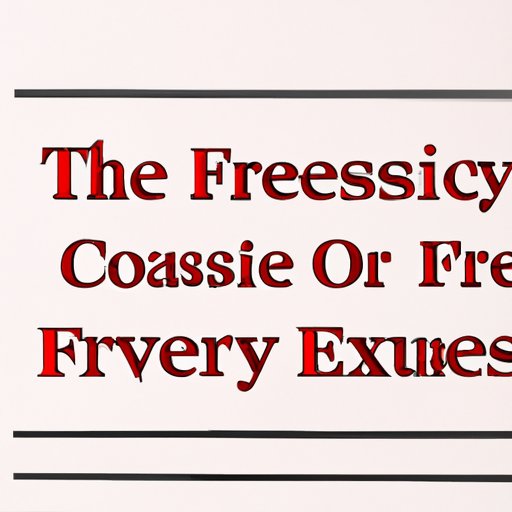
Introduction
The Free Exercise Clause is a crucial aspect of religious freedom in America and is enshrined in the First Amendment of the US Constitution. It protects the right of individuals to freely practice their religion without government interference. Understanding the boundaries of this clause is paramount to ensuring that one’s religious freedom is protected. In this article, we will explore the Free Exercise Clause, what it means, what is allowed, and its limitations and boundaries.

Understanding the Free Exercise Clause: What it Means and What is Allowed
The Free Exercise Clause guarantees individuals the right to practice their chosen religion without government interference. It is part of the First Amendment of the US Constitution, which prohibits the government from establishing a religion and protects the freedom of individuals to practice their religion. The Supreme Court has recognized that the Free Exercise Clause provides broad protection for religious practices.
Examples of protected religious practices under the Free Exercise Clause include attending religious services, wearing religious clothing, and engaging in religious rituals or practices. The government may not interfere with these activities, even if they may be seen as unconventional or weird by others in society.
Religious Liberty in America: Exploring the Boundaries of the Free Exercise Clause
While the Free Exercise Clause provides broad protection for religious practices, there are limits to this protection. The government may regulate religious practices if they pose a threat to public health, safety, or welfare. Examples of practices that may be regulated include animal sacrifices, polygamy, and the use of illegal drugs in religious rituals.
Courts have used a balancing test to determine whether a government regulation that affects religious practice is constitutional. The balancing test weighs the government’s interest in regulating the activity against the burden placed on the individual’s religious practice. If the government has a compelling reason for regulating the activity, and there is no less restrictive means to achieve its goal, the regulation may be upheld.
The Free Exercise Clause and its Limits: A Guide to What Actions are Permitted
Actions that are deemed as violating or threatening public health, safety, or welfare are not protected under the Free Exercise Clause. This includes activities such as using illegal drugs, human sacrifice, or child abuse.
However, the government cannot use a regulation or law to target a particular religion or religious group. For example, a law that prohibits the use of peyote for religious purposes would be unconstitutional if it only applied to members of certain Native American tribes.
Additionally, the government must demonstrate that its interest is compelling, and any regulation must be the least restrictive means of achieving that interest. For example, the government may regulate animal sacrifices if they pose a threat to public health but must ensure that the regulation is not discriminatory against a particular religion or religious group and does not place an undue burden on their religious practices.
Religious Freedom in the United States: How the Free Exercise Clause Protects our Rights
The Free Exercise Clause has been used to protect the religious freedom of individuals and groups in the United States. An example of this is the Supreme Court decision in Church of the Lukumi Babalu Aye v. City of Hialeah, which struck down a city ordinance that banned the ritual slaughter of animals. The Court held that the ordinance discriminated against the Santeria religion, as it exempted other activities such as hunting and fishing, which also involved animal slaughter.
Religious freedom is essential to American society as it allows individuals to freely practice their beliefs. This creates a diverse and pluralistic society where individuals can express themselves freely without fear of government interference.
Navigating the Free Exercise Clause: A Look at the Rules and Legal Precedents
The legal principles and rules that apply to the Free Exercise Clause can be complex and difficult to navigate. Individuals who are navigating legal issues related to religious freedom should seek legal advice from an experienced attorney.
Legal precedents related to the Free Exercise Clause provide guidance on what is permissible under the clause. These precedents are based on balancing the individual’s right to religious freedom against the government’s interest in regulating the activity. Courts have applied these principles in various cases to determine the constitutionality of government regulations that affect religious practices.
Exercising your Religion in America: A Closer Look at What is Permissible
Individuals who wish to exercise their right to religious freedom in America should consult an experienced attorney who can provide guidance on what is permissible under the Free Exercise Clause. If an individual believes that their religious freedom has been violated, they should seek legal advice to determine whether they have a viable claim.
It is important that individuals who are exercising their right to religious freedom do not violate laws that pose a threat to public health, safety, or welfare. Engaging in illegal activities, even if they are religious practices, can result in legal consequences.
The Free Exercise Clause and the Constitution: A Detailed Analysis of its Interpretation and Application
The Free Exercise Clause is an essential aspect of religious freedom in America and is protected under the US Constitution. The clause has been the subject of numerous court cases that have established legal precedents related to the boundaries of the clause.
The Supreme Court has recognized that individuals have a constitutional right to practice their religion freely, without government interference. However, this right is not absolute and may be limited if it poses a threat to public health, safety, or welfare.
Conclusion
The Free Exercise Clause is an essential aspect of religious freedom in America. Understanding the boundaries of this clause is crucial to ensuring that one’s religious practices are protected. While the government may regulate religious practices that pose a threat to public health, safety, or welfare, regulations must be the least restrictive means of achieving the government’s interest, and they cannot be discriminatory against a particular religion or religious group.
If you believe that your religious freedom has been violated, it is essential to seek legal advice from an experienced attorney. By doing so, you can determine whether you have a viable claim and navigate the legal issues related to the Free Exercise Clause.




